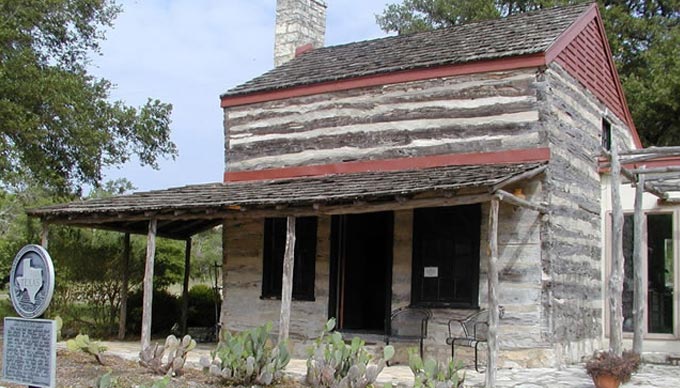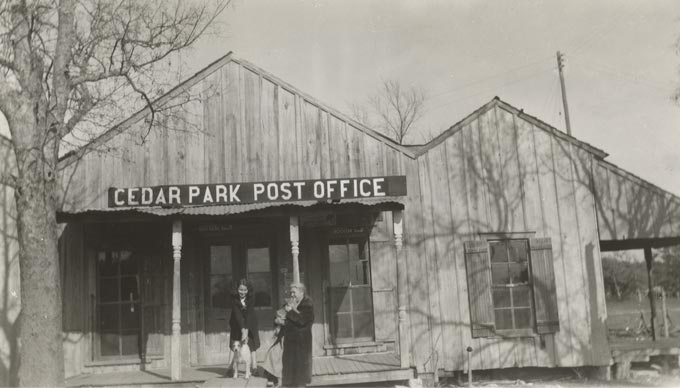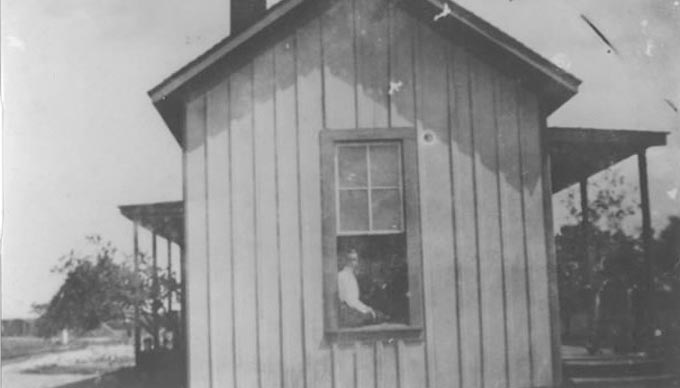By John Hallowell
Cedar Park today is a modern suburb of Austin, with comfortable homes and pleasant neighborhoods surrounding highways lined with thriving businesses. But not so long ago, it was a small Hill Country town on the northbound railroad, subsisting mostly by selling local cedar and limestone.
Photo: cedarparkhistory.com
While there had been a few scattered pioneers in the area since the 1830s, the actual town (first called Running Brushy, for the local spring) grew around the 329-acre ranch of George and Harriet Cluck, veterans of the legendary Texas cattle drives (Harriet was reportedly the first woman to ride the Chisolm Trail) who purchased the land in 1873. When the fledgling community earned its own post office in 1874, Harriet Cluck became postmistress. In 1877, a limestone quarry was dug on the Cluck property, near the present intersection of 1431 and Lakeline Blvd. It grew to be the town’s largest employer in the late 1800s.
In 1879, a small community church and schoolhouse was built in the little town. The narrow-gauge railroad from Austin came through on its way to Burnet in 1881, and a depot and foreman’s house were built on the cluck property. Three railroad workers were housed in army huts next to the foreman’s house. The community changed its name to Bruggerhoff in 1883, in honor of a railroad executive, but the name was not popular with the locals; in 1887, Emmett Cluck (George and Harriet’s son) changed the name to Cedar Park.
Photo: cedarparkhistory.com
In 1892, an actual park of about a half acre was built near the train depot, and Austinites would ride the train to it for a day’s excursion. As demand grew for cedar posts, cedar yards were started in Cedar Park, and quite a few men earned a living for their families by chopping cedar trees by hand with a single or double-bit axe. Posts were sorted at the yards for size, straightness and length, then sold for use as fence posts or cabin beams. After the great hurricane of 1900 struck Galveston, limestone from Cedar Park was used to build the sea wall there. In 1929, a railroad spur was built from the main line to the quarry to make shipping easier.
In 1935, a new cedar mill was built in Cedar Park to extract cedar oil and make “floor sweep” from leftover bits of the cedar trees. In 1943, the State of Texas built a dairy and hog farm at Cedar Park. The town remained small and relatively poor until the 1970s, when Austin’s growth made Cedar Park a desirable location as a bedroom community.
The community voted to incorporate as a city in 1973; the population exploded from 687 in 1970 to more than 60,000 (estimated) in 2009. In 1976, the southern Pacific Railroad ended its operations in the Austin area, and sold 167 miles of track to the City of Austin. In 1989, the Austin Steam Train Association was formed, using the old Engine #786, which had been donated to the city in 1956. The “Hill Country Flyer” began its excursion runs from Cedar Park to Burnet in 1992.
Photo: cedarparkhistory.com
A year later, Cedar Park became the headquarters of the ASTA, when a new rail yard was built on 16 acres donated by Texas Commerce Bank and developed using funds from a state grant. Ridership on the Hill Country Flyer has grown steadily in recent years, and Capital Metro now operates a regular commuter service from Leander, through Cedar Park, to Austin. The railroad is once again a centerpiece of downtown Cedar Park.
In addition to great shopping, dining and lodging accommodations, the City of Cedar Park offers a unique concession on Brushy Creek. It’s called RowPaddle, and kayaks (and kayaking lessons are available to beginners or veterans at low hourly rates. A more recent development is the fantastic Cedar Park Center, a state-of-the-art sports and entertainment arena with a capacity of more than 8,000. It is the home of the Texas Stars hockey team and has hosted many other memorable events, including a sold-out concert by country music legend George Strait at its Grand Opening in 2009.
There are few clues left in this modern city to the small rural community that existed just 40 years ago, but one of Cedar Park’s historical treasures is the John M. King log house, thought to date from 1859. It is located off Volente road, north of the Dies Ranch Road, on a one-lane road a couple of miles south of the original Cluck property.






